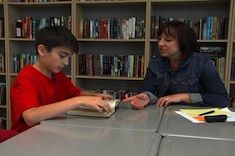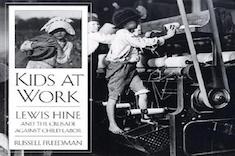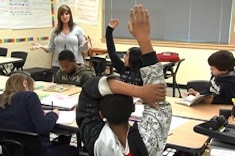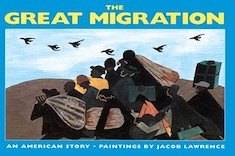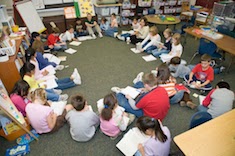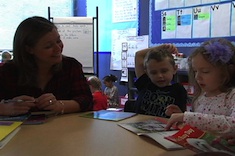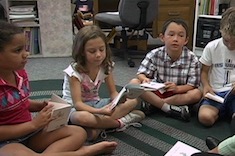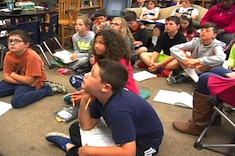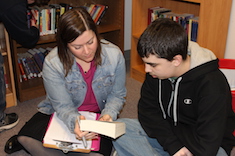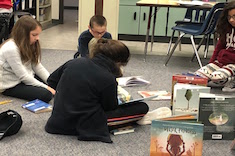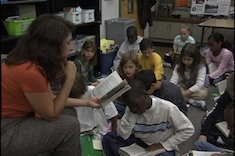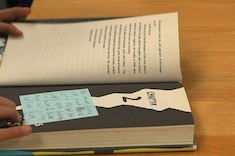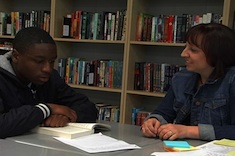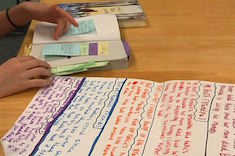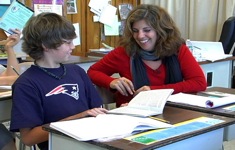Teaching Reading
Our contributors lead reading workshops in classrooms with creative flair. Over the past 12 years, we've filled our site with loads of suggestions, tools, and tips for using engaging books throughout the curriculum to hook kids on reading. Here is where you will find many stories of successful and not-so-successful workshop days, and what we learned from them. We bring these stories to life through hundreds of video examples.
Latest Content
History Through a Child’s Eyes: Conferring with Omar
Christy Rush-Levine confers with Omar, who is reading The Rock and the River. The book is a fictional account of a tumultuous time in civil rights history, considering protests through a child’s eyes.
Russell Freedman Book Clubs
Mark Levine finds Russell Freedman book clubs are a great way for his middle school students to deepen their understanding of history and empathize with young people who have lived through previous eras.
Balancing Whole-Class and Independent Reading in Middle School
The choice between whole-class novels or independent reading can be a false one in many middle school classrooms. Katie Doherty’s sixth graders discuss their reading together of a novel in verse, and Katie explains how some shared whole-class texts can support independent reading.
Expanding Black History Month Reading
A heavy sigh from a student is a cue to Shari Frost that he has heard the same Martin Luther King picture book biography one too many times in February. She shares her top picture book picks for expanding children’s awareness of black history all year long.
Annotating While Reading
Franki Sibberson finds teaching students to annotate while reading is one of the best ways to promote ongoing reflective response in her fifth-grade classroom. She shares how she starts teaching annotation skills early in the year.
What Does It Mean to Read?
“I read 35 pages!” An elated student deflates Bitsy Parks in her first-grade classroom. By mid-fall she is alarmed at students’ responses to their reading in the whole-group share—they are all about quantity, with no thinking or reflection. She uses modeling and careful questioning to foster more thoughtful reader response.
Reader Response as an Entry to Conferring
Christy Rush-Levine integrates reading responses into her preparation for reading conferences, and then uses the responses as a tool to build goals and insights within the conference.
Reading Conference: Keeping Track of Characters
Christy Ruth-Levine confers with Edith, who is tracking character changes in the novel Room.
Three Challenges for the 40 Book Challenge
Matt Renwick encourages you to ask a few critical questions before you adopt the 40-Book Challenge or any other activity with a number for a goal you’re going to be tied to all year long in your classroom.
Levels and What’s Appropriate
“How do you know what level they have selected?” a visitor asks Bitsy Parks as she observes during a first-grade independent reading period. “I don’t,” Bitsy responds, and explains why it is a beautiful thing.
Guided Reading Run Amok
Shari Frost helps a teacher who has guided reading groups that have run amok, and discovers that the real culprit is a lack of time for reading and writing in the literacy block.
First-Grade Reading Share: Focus on Conferring and Strategies
Bitsy Parks uses reading share time early in the year to describe and summarize the work in two conferences to help students learn how conferring, independent reading time, and strategy practice work. One of the books used in a conference is from a recent read aloud.
Organizing for Middle School
Tara Smith covers all the basics of how to get organized in middle school for the first days of literacy workshops.
Keeping the Classroom Library Current
Franki Sibberson explains how she watches students closely and adjusts her library based on what she sees all year long.
Fifth-Grade Book Talk: Wish Girl
Katherine Sokolowski builds interest in a new book in the classroom library through a book talk on Wish Girl.
How to Get Books Off Shelves
Christy Rush-Levine writes about the push and pull of wanting to put books into students’ hands, and needing at the same time to give them room to explore the classroom library.
When One Door Closes
Gretchen Schroeder finds new routines in her high school workshop means letting go of old expectations.
First-Grade Read and Think Check-In
Katrina Edwards demonstrates a read and think check-in from her first-grade classroom.
Invitations vs. Accountability
It’s not an invitation if students are required to accept it. Franki Sibberson explains how engagement depends upon true choice and lots of options in her fifth-grade classroom.
The Year’s First Read Aloud
From length to heart, Tara Smith provides seven criteria for selecting the first read aloud of the year that can engage students right from the start.
Student Notes: Slow Down and Think
Fifth grader Orion uses sticky notes to make questions and predictions at the end of each chapter.
Student Notes: Reading for Writing
Reagan, a fifth grader in Franki Sibberson's class, explains how she uses sticky notes to flag examples of writer's craft she could use in her own writing.
Student Notes: Reminders for Later
We continue our video series from Franki Sibberson's class of fifth graders explaining how they take notes while reading. Sarah marks important elements early in the mystery she is reading, so she can easily refer to them later.
From Title to Theme: Conferring with Jadev
Christy Rush-Levine confers with Jadev about how the title of a book often gives clues to its theme.
Splashing Around to Find Themes
Christy Rush-Levine moves from emphasizing theme to teaching strategies for understanding text, and finds it’s a much better way to get her eighth graders to grapple with theme in natural, organic ways.
Getting to the Heart of Theme
Tara Smith shares many strategies for helping her sixth graders get to the heart of understanding themes in literature.
Comics and Graphic Novels for Tweens
Comic books and graphic novels are genres tweens adore, but teachers sometimes struggle to embrace. Ruth Shagoury creates a booklist with engaging books in the genre any teacher would enjoy.
Student Notes: Keeping Track of Many Characters
Tre uses lots of sticky notes to sort through and keep track of characters in a book with a whole classroom full of personalities.
Student Notes: Experimenting with Two Strategies
What do student notes from independent reading look like when students have free choice? In this video series, fifth graders from Franki Sibberson's class explain their notetaking strategies. We start with Ally, who tries out two different strategies to figure out which one will help her the most.
Conferring: Establishing a Setting in a Novel
In this week's video, Aimee Buckner has a quick conference with a fourth grader about ways to solve a dilemma — how to figure out the setting in a historical fiction novel when there are no pictures.
Browse Content By
Type
Category
- Assessment Tools
- Big Fresh Archives
- Booklists
- Choice Numeracy
- Classroom Design
- Common Core
- Community Building
- Conferring
- Content Literacy
- Digital Literacy
- English Language Learners
- Equity
- Family Relations
- Free Samples
- Guiding Groups
- Leadership
- Literacy Coaches
- Mentor Texts
- Minilessons
- New Teacher Mentors
- Podcasts
- Poetry
- Quote Collections
- Reading Strategies
- Self Care
- Struggling and Striving Learners
- Talking and Listening
- Teacher Study Groups
- Teaching Reading
- Teaching Writing
- Word Study and Vocabulary
Author
- Melissa Quimby
- Nawal Qarooni
- Gwen Blumberg
- Julie Cox
- The Lead Learners
- Hannah Tills
- Josie Stewart
- Ruth Metcalfe
- Mallory Messenger
- Becca Burk
- Jodie Bailey
- Vivian Chen
- Mary Brower
- Tiffany Abbott Fuller
- Stephanie Affinito
- Ruth Ayres
- Leigh Anne Eck
- Heather Fisher
- Shari Frost
- Julie Johnson
- Suzy Kaback
- Gigi McAllister
- Shirl McPhillips
- Melanie Meehan
- Cathy Mere
- Debbie Miller
- Tara Barnett and Kate Mills
- Tammy Mulligan
- Dana Murphy
- Bitsy Parks
- David Pittman
- Brenda Power
- Heather Rader
- Matt Renwick
- Mandy Robek
- Christy Rush-Levine
- Gretchen Schroeder
- Jen Schwanke
- Brian Sepe
- Katherine Sokolowski
- Stella Villalba
- Jennifer Vincent
Grade Level
Choice Literacy Membership
Articles
Get full access to all Choice Literacy article content
Videos
Get full access to all Choice Literacy video content
Courses
Access Choice Literacy course curriculum and training

